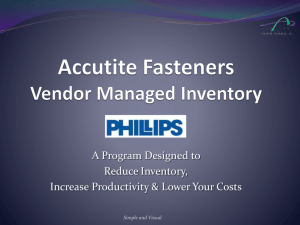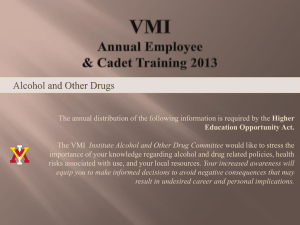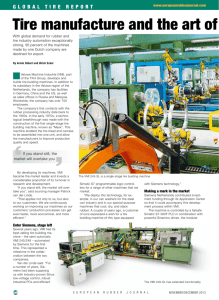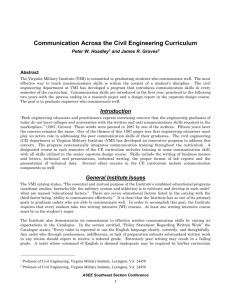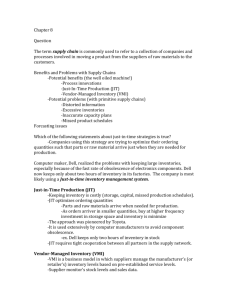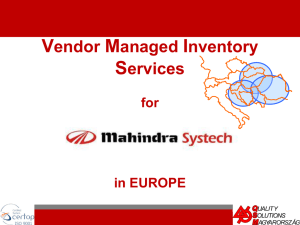inventory management
advertisement
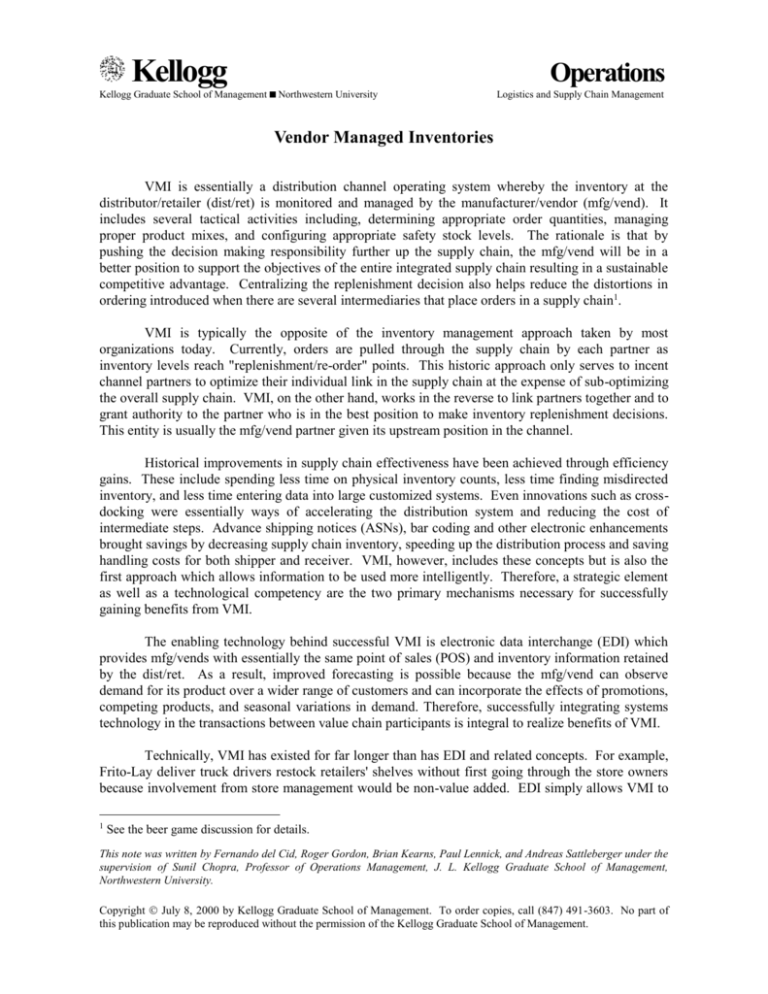
Kellogg Operations Kellogg Graduate School of Management ■ Northwestern University Logistics and Supply Chain Management Vendor Managed Inventories VMI is essentially a distribution channel operating system whereby the inventory at the distributor/retailer (dist/ret) is monitored and managed by the manufacturer/vendor (mfg/vend). It includes several tactical activities including, determining appropriate order quantities, managing proper product mixes, and configuring appropriate safety stock levels. The rationale is that by pushing the decision making responsibility further up the supply chain, the mfg/vend will be in a better position to support the objectives of the entire integrated supply chain resulting in a sustainable competitive advantage. Centralizing the replenishment decision also helps reduce the distortions in ordering introduced when there are several intermediaries that place orders in a supply chain1. VMI is typically the opposite of the inventory management approach taken by most organizations today. Currently, orders are pulled through the supply chain by each partner as inventory levels reach "replenishment/re-order" points. This historic approach only serves to incent channel partners to optimize their individual link in the supply chain at the expense of sub-optimizing the overall supply chain. VMI, on the other hand, works in the reverse to link partners together and to grant authority to the partner who is in the best position to make inventory replenishment decisions. This entity is usually the mfg/vend partner given its upstream position in the channel. Historical improvements in supply chain effectiveness have been achieved through efficiency gains. These include spending less time on physical inventory counts, less time finding misdirected inventory, and less time entering data into large customized systems. Even innovations such as crossdocking were essentially ways of accelerating the distribution system and reducing the cost of intermediate steps. Advance shipping notices (ASNs), bar coding and other electronic enhancements brought savings by decreasing supply chain inventory, speeding up the distribution process and saving handling costs for both shipper and receiver. VMI, however, includes these concepts but is also the first approach which allows information to be used more intelligently. Therefore, a strategic element as well as a technological competency are the two primary mechanisms necessary for successfully gaining benefits from VMI. The enabling technology behind successful VMI is electronic data interchange (EDI) which provides mfg/vends with essentially the same point of sales (POS) and inventory information retained by the dist/ret. As a result, improved forecasting is possible because the mfg/vend can observe demand for its product over a wider range of customers and can incorporate the effects of promotions, competing products, and seasonal variations in demand. Therefore, successfully integrating systems technology in the transactions between value chain participants is integral to realize benefits of VMI. Technically, VMI has existed for far longer than has EDI and related concepts. For example, Frito-Lay deliver truck drivers restock retailers' shelves without first going through the store owners because involvement from store management would be non-value added. EDI simply allows VMI to 1 See the beer game discussion for details. This note was written by Fernando del Cid, Roger Gordon, Brian Kearns, Paul Lennick, and Andreas Sattleberger under the supervision of Sunil Chopra, Professor of Operations Management, J. L. Kellogg Graduate School of Management, Northwestern University. Copyright July 8, 2000 by Kellogg Graduate School of Management. To order copies, call (847) 491-3603. No part of this publication may be reproduced without the permission of the Kellogg Graduate School of Management. Vendor Managed Inventory be applied to a broader range of products and for more value-adding analysis to be conducted on available data. Nevertheless, organizations that are taking VMI to test have begun to realize that a "tailored" approach to incorporating both the strategy and technology is essential to success. Issues When Introducing VMI Initial problems with VMI often relate to systems/data limitations. Initially it is probably best to narrow the focus of VMI and to better understand configuration, operational, and procedural issues prior to larger-scale implementation. For success it is key to be able to move vendor relationships in a direction of minimizing total supply chain cost for all stakeholders. The cost saving benefits will then be available to all parties. A pilot program may incorporate the following elements A few vendors (any that are already running VMI with other customers) who represent top suppliers in terms of relationship, competency, and willingness to test VMI concepts in an active supplier-distributor relationship should be considered. An EDI protocol standard to transmit information nightly has to be agreed upon. A set of SKUs involved must be decided upon. Initially a high degree of human involvement may be required till the system stabilizes. At this point, the pilot program often runs into process and conceptual concerns that are typical of organizations moving to true full-scale VMI. These include: The belief that the dist/ret can manage its inventory better than their vendors due to the customized nature of their systems and the responsiveness of their replenishment team, and their dedication to minimizing inventory while maintaining appropriate stocking levels in support of high customer cycle service rates. The limitations of existing computer system. The overall goal must be to support total value chain cost minimization by pushing decision making on replenishment activities furthest up the supply chain. This approach supports cost savings because the value of pooling orders and producing to accurate demand patterns with timely information (i.e., variability minimization) yields lower inventory investment if executed effectively. The complexity, however, is in allocating the savings gained to each participating supply chain stakeholder effectively and fairly. As a benchmark to measure progress of the pilot program, the company can initiate improvement goals for vendors involved in the pilot program. However it is important that VMI be implemented in its truest sense, else it will be difficult to assign a cause to any failures. Pilot programs tend to reveal several challenges for implementing the concept: redefining the relationship with the vendor, handing over previously considered proprietary information, new processes and job tasks, setting up new metrics for measuring the vendor's performance, and establishing electronic connections are some of the key issues. These and other issues will need to be resolved collectively by supply chain partners and can take considerable time but, nevertheless, move the organization in the right strategic direction. 2 Vendor Managed Inventory VMI BEST PRACTICES What have organizations been able to gain as a direct result of incorporating both the strategic and technical elements of VMI in their operations? From our research, VMI can have a number of benefits, including lowered investment in the supply chain (due to better forecasting), JIT delivery and less overstocking) and greater inventory turnover. Its primary benefit, however, is improved customer service due to fewer stockouts and more optimal product mixes. Mfg/vends also stand to benefit from VMI, as it allows them to schedule production and transportation more efficiently (including ordering raw materials), to observe end-user consumption and general market trends more closely, and to develop closer ties with their customers. In summary, the benefits are as follows: Typical Benefits to Mfg/Vend Lower inventory investment (raw and finished) Better scheduling and planning Better market information Closer customer ties and preferred status Typical Benefits to Dist/Ret Fewer stock-outs with higher turnover Better market information More optimal product mixes Less inventory in channel (transfer costs) Lower administrative replenishment costs As previously mentioned, it is clear that a number of critical components must come together to form a successful VMI program. If these components are present the results can be dramatic: At K-mart, customer service measures have gone form the high 80s to the high 90s. Inventory turns on seasonal items have gone from 3 to between 10 and 11, and for the non-seasonal items form 12-15 to 17-20. ACE Hardware, the large hardware cooperative, has seen fill rates rise 4% to 96% in the past few years. Fred Meyer, the 131-unit chain of supercenters in the Pacific Northwest, reduced inventories 30% to 40%, while sales rose and service levels increased to 98%. This was due to a VMI program implemented with two key food vendors. Grand Union, a New Jersey-based grocery retailer with more than 100 stores and three DCs, improved inventory turns by close to 80% and achieved 99% service levels. This significantly improved sales by eliminating out-of-stock conditions and dramatically reduced warehousing costs. Oshawa Foods, a $6 billion Canadian food distributor and retailer, had tremendous success with Pillsbury, Quaker and H.J. Heinz with turns improving from 3 to 9 times, while achieving customer service levels of 99%. This, however, came after some initial adjustments in the program because of the hasty nature of initial implementation. Panduit, one of the largest manufactures of components for the electrical industry with 60K skus was able to leverage its market position to develop a new computer system to reduce replenishment costs which were squeezing profitability out of the entire supply chain. Because its distribution network didn't see cost savings in the incorporation of VMI, Panduit developed a new turnkey VMI/EDI system called Qualified Supplier Program (QSP) created by an external vendor Advantis specifically in support of a tailored approach for its industry. As a result, Panduit claims 3 Vendor Managed Inventory that their distributors are providing better service to their customers, out of stock conditions have been reduced to a minimum, and its customers are tightly linked as long-term stakeholders in its business ensuring long-term supply chain stability. The reasons these highlighted organizations have been able to achieve dramatic improvements are widely varied, but center around a strategic approach to viewing the entire supply chain. Specifically, these include: Focus your Efforts Trust and Partnership between Supply Chain Stakeholders Highly Effective Computer Systems Competent Mfg/vends and the Ability to Forecast Willing Stakeholder Partners and Patience Focus your Efforts As one senior principal at EDS2 put it: "The average billion-dollar company may have 20,000 suppliers, and you can't do EDI with 20,000 companies. . . [but if the company limits EDI to the suppliers that account for 80 percent of their purchases] then you've gone down to maybe 200 suppliers, and you can do EDI with 200 companies." Since EDI is fundamental to VMI, the same principle applies when moving to a VMI solution. Another example is ACE hardware, where only 13% of the volume is handled by VMI sources. In a survey of the mass retail industry, respondents expected vendor managed programs to exceed 10% of volume in hard goods in the next three years and 7% of soft goods. Therefore, it is important to note the concept of focusing on partnerships where each participant is capable or at least willing to develop VMI competency. Trust and Partnership between Supply Chain Stakeholders If the VMI program does not have credibility and is not built upon a foundation of trust, then it is useless to try to implement it. One grocery chain, Spartan Stores, "pulled the plug" on their VMI program, and they freely admitted that a lack of trust was a main reason the program failed; or as they put it, "The buyers trusted the suppliers, but not as much as the buyers trusted themselves". According to Spartan's director of purchasing, "Because the VMI efforts have been less than perfect, they [the buyers] did what they did before, plus they were monitoring it like crazy. And if something went wrong, they ended up getting directly involved. There has never been enough credibility in the process alone that you could just ignore it." Therefore, we believe that not only is the support of top management fundamental to establishing the trust between the firms, but that operational employees must be sufficiently incentivized to support a trusting orientation. Trust, however, is a hard thing to created overnight. Organizations must work over time to support such arrangements similar to Japanese organizations that have formed functional departments specifically to generate closer partnership ties with suppliers. 2 EDS is a major systems integrator that also has support of a consulting practice (AT Kearney) that specializes in assisting organizations become cost competitive with technology applications (like VMI/EDI, etc). 4 Vendor Managed Inventory Highly Effective Computer Systems It is abundantly clear that in every company that we benchmarked in the pursuit of .understanding VMI, effective systems were a key to the successful implementation of VMI. As one executive at ACE Hardware put it, "don't entertain thoughts of faxing". Admittedly the costs of EDI/VMI are significant and according to The EDI Group,3 in 1995 the cost of a "Hub" (W. W. Grainger) to communicate with several suppliers was $200,000 a year and required 3.86 employees dedicated to it. The cost of a "Spoke" for a smaller company communicating electronically with only a few firms is $20,000 a year and required 1.54 employees. The benefit is obvious, nevertheless, the systems limitations must be overcome to support long-term strategic approaches especially considering Grainger's start-up approach. Competent Mfg/Vends and the Ability to Forecast The theory upon which VMI is founded is that the mfg/vend is more competent to manage and forecast inventory than their dist/ret partners. According to John White, one of the members of the logistics steering committee for the International Mass Retailers Association, the theory works as follows: "Retailers are used to a trigger point mechanism, sometimes called model stock. You try to set model stock based on forecasting, but that's a reactionary system. Not many retailer systems are set up on DRP logic." The extent to which the mfg/vend can better manage their own inventory and shipping based upon better information from the dist/ret, sets the limits on the success of the VMI program. Essentially, VMI attempts to use POS data and known inventory levels to optimize production so that both manufacturing and distribution costs are minimized and customer demand is met. This is obviously a very complex task, and Grainger has to evaluate their suppliers to judge their competencies in all of these areas as additional mfg/vend partners are selected as the pilot program is expanded. K-Mart, who we have cited throughout this review for their successes with VMI, has scaled back their VMI program to just 50 suppliers (from a high of 300). This reflects the inability of many of their suppliers to effectively forecast, which resulted in higher out-of-stocks with some items. The failure of K-Mart and the subsequent re-focusing indicates that significant investment in developing ones mfg/vend's competencies in forecasting and inventory management are a key tenet to successful VMI programs. At some point, however, re-focusing may be necessary if its affiliate partners are unable to move on VMI effectively. An alternative example from K-Mart's experience is Whitehall-Robbins, who have been able to achieve success from their innate knowledge of the production facilities. Whitehall-Robbins knows how to build inventory with K-Mart if the Advil plant is scheduled for downtime because their forecasting systems are highly integrated. As a result, product returns have also been reduced because pre-season bulk discounts have been eliminated in favor of week to week forecasts and deliveries. 3 The EDI Group supports studies on the status of EDI and is located in OakBrook, Illinois. 5 Vendor Managed Inventory Willing Stakeholder Partners and Patience One standard for choosing suppliers was provided by Grand Union, who selected vendors that were market leaders in their respective categories, as well as technology and supply chain innovators. This included the realistic perspective that no VMI program could be set up overnight. Similarly, time was needed where at Fred Meyer management started in 1991 by implementing EDI, then in 1992 moved to computer-assisted replenishment programs. In 1993 they finally moved to VMI. It took significant time and investment, but it paid off and continues to do so today. Nonetheless, some VMI programs have been set up quickly. Oshawa Foods set up their . program with Pillsbury in 6 months, with Quaker in 3 months, and with H. J. Heinz in 3.5 weeks, in part because these trading partners "claimed" to already have varying degrees of experience with VMI. As a result of this hasty approach, Oshawa ran into many problems similar to Grainger's initial attempt at VMI two years ago. In the end, Oshawa was able to gain measurably, but it took a minor re-focusing. In total, VMI best practices can be uncovered when one understands that significant effort will yield results. Each organization was able to "tailor" their approach based on specifics of their industry and competencies of their supply chain partners. For some, success was negligible, for others it was significant and led to other paradigm shifting improvements. VMI'S POTENTIAL PROBLEMS Successful VMI programs depend on several critical factors, some of which are not immediately obvious. This has led to much confusion in the distribution and retail industries, as suppliers and buyers have sought to implement VMI as the newest improvement to their existing systems. VMI, while a logical outgrowth of EDI, Efficient Consumer Response (ECR), Category Management (CM) and other programs, is qualitatively different. VMI depends upon the availability of solid and comprehensive consumer data (POS). Without such "live" information, the benefits of VMI begin to become elusive. The mfg/vend must understand the true nature of POS data and how the dist/ret is using the stock that is ordered. While previously it was sufficient to know that X number of units were ordered, under VMI, the supplier needs to know whether those units were being inventoried (and for how long), whether they were special orders, if they were ordered just to create full truck loads, the number of end users the units were going to, and so on. Moreover, efficient inventory management and production scheduling requires close communication regarding promotions, seasonal variation, and new product introductions and selling incentives that may impact the ability to forecast accurately. Thus, exceptions communication must also be incorporated beyond the automated nature of data transfer under VMI. Close supply chain communication is typically best addressed through routine and adhoc conference calls, video conferencing, and email systems. Problems with VMI What makes VMI different from EDI and its other incarnations is that it passes control of the supply chain as far up the supply chain as possible to support production pooling and inventory minimization. Thus, VMI should only be implemented in cases where the mfg/vend can forecast 6 Vendor Managed Inventory demand more accurately than the dist/ret. As pointed out earlier, however, the competency to forecast and determine order levels is a learned capability. This indicates that supply chain partners should decide strategically who should hold such responsibility, and then let that entity develop the competency. Making inaccurate decisions in this area can lead to more problems. As well, change must become quickly adopted as "tweaking" will become the norm not the exception. Clearly, there are industries where the vagaries of consumer demand, local conditions or market size dictate that the dist/ret should retain control of inventory management. This was the case with K-Mart, which after reducing the number of vendors it worked with and implementing VMI, discovered that its own buyers could do a better job of forecasting consumer demand in certain circumstances. Some market conditions do not make VMI the best solution and a tailored/hybrid approaches need to be explored. Specifically, the "silver bullet" approach will lead to problems if organizations accept VMI as an end-all solution. One question that could not be resolved in reviewing the activities of many VMI programs is for what type of products VMI will and will not work. This is a complex question where high volume, high turn items, like disposable diapers, are popular candidates because they are low hanging fruit, while "best of breed" organizations have had success in other product types. WalMart and P&G have had a VMI program together for over ten years to manage the inventory and production of disposable diapers, with great success: turns doubled, WalMarts' operating costs fell, and P&G's market share grew (because WalMart gave it preferred shelf space). However, the opinion that nonvolatile, low-turn products would also benefit was also expressed, and none of the reported failures revolved around the type of product included in the programs. This may indicate an appropriate starting point to chose mfg/vends that have capabilities but also that produce such products. Additionally, the answer depends on a number of variables that need to be considered, including: What percent of their total volume do the VMI vendors sell through the dist/ret? What capabilities do the vendors have in the area of forecasting or retail inventory management? How flexible will the system be in the event of required changes and modiications? Will there be minimum volume or exclusivity requirements? What product items are being considered? Another, more fundamental, problem with making vendors responsible for retailers' inventories is the fact that mfg/vends traditionally want to push product (i.e., maximize inventory), while retailers want to minimize inventory (i.e., optimize sales). Overcoming this dichotomy requires trust that both parties are seeking long term profitability. The dist/ret should also assure itself that the interests of the mfg/vend salespeople are aligned with its own. Elements that need to be considered include: How will the mfg/vends' salespeople be compensated? How will special pricing and promotions be handled? How will the benefits of VMI be split? What dist/ret sales and volume data should be kept confidential? What are the mfg/vends' other channels? As distribution systems become more sophisticated, the mechanical aspects of providing outstanding service--whether its next day delivery or access to a broad network of manufacturers--will 7 Vendor Managed Inventory become more accessible to all firms. Service, therefore, from a distribution aspect, may not translate into a sustainable competitive advantage, however knowing which products, in what quantities, and where to store them, may be. OUTLOOK AND FUTURE OF VMI Logistics experts have recently published the results of the annual logistics survey4 that shows the acceleration of trends towards cycle time compression, reduced inventory, increased inventory velocity and greater use of EDI. According to these researchers, more industries are paying closer attention to supply chain management. The survey results show that information technology and supply-chain management will most affect the future growth and development of logistics. The results of the survey forecast an increase in inventory turns, which survey respondents said will rise from 30% to 40% by the year 2000. They also show that pooling of shipments is re-emerging as a Logistics strategy (14.2% - '94, 17.8% - '96 and 27.5% -2000). This implies that companies are becoming increasingly competitive in determining what inventory to carry while offering quicker and more customized service. According to LaLonde, this can be attributed directly to the application of VMI, which will increase from 4% of inbound shipments'. in '94 to 19% by the year 2000. According to another survey released by the International Mass Retail Association (IMRA), VMI programs will grow substantially in the near future.5 Over 60% of hard goods and almost 40% of soft goods are now under replenishment programs managed by retailers. The survey projects very little growth beyond these levels. On the other hand, respondents mentioned that VMI programs are intended to grow within their organizations from insignificant levels today to 10% of volume in the next three years for hard goods and about 7% for soft goods. Is VMI just a logistics fad or is it a trend in supply-chain management? It can be argued that VMI is very similar to Continuous Replenishment (CR). The major difference between CR and VMI is that under VMI the mfg/vend is in charge of what to ship and when to ship it. In a sense, VMI can be considered the next step after CR in the process towards an integrated supply chain. We can then predict VMI transforming into Consignment Selling (CS) approaches and then theoretically the elimination of intermediary channels in support of direct selling (see Figure 1). 4 Bernard J. LaLonde performs a survey of 200 chief logistics officers at major corporations in conjunction with Ohio State University. LaLonde was the former head of Ohio State's transportation and logistics program and is now a professor emeritus. 5 To order a copy of this report contact IMRA 1700 North Moore St. Suite 2250, Arlington, VA 22209 (703) 841-2300. 8 Vendor Managed Inventory Conceptual Evolution of Inventory Management Owner Managed Inventory CR Consignment Selling VMI Direct Selling Figure 1 CS is similar to VMI, but differs in one basic area. In VMI, the retailer still owns the inventory and the manufacturer simply manages it. CS can be considered the next step (after VMI), where the manufacturer owns the inventory and the retailer charges a percentage for providing shelf space and customers. CS has not been tried at full scale at the moment. The mass merchants (e.g. WalMart) could be the first to convert from a VMI system with P&G to CS. This might change the roles of the manufacturer and the retailer. The next step in the conceptual evolution could then be direct selling. Under direct selling, the manufacturer would take charge of the total vertical chain. They would not only have the POS information, but would also have control over the channel flows. 6 This implies that in the long run mfg/vends could become more powerful than any of the other supply chain participants. This emphasizes why a strategic alliance is crucial for the success of any trust based relationships such as VMI. Sharing information and distributing the margins equitably based on the distribution flows performed by each member may be a good theoretical approach. Reality shows a different trend. As manufacturers perform more roles in the supply chain it is predicted that they will begin to seek out additional margins to cover these new costs. As a result, they may chose to bypass existing channel arrangements in an effort to capture a larger piece of the pie. An extreme scenario eliminates the product flow through distributors and retailers, where manufacturers would sell their products directly to a new partner: the end users through the Internet. In essence, the Internet would serve as the live communications tool (EDI lets say) with millions of channel partners. This approach is used in Singapore for individuals purchasing cars from Honda. Essentially, the "auto-dealer" has been pushed out of the picture. Limitations, of course, will impact which products this model would apply to, but it nevertheless indicates a direction that technology will allow aggressive manufactures to move. The previous arguments backs up why VMI should not be solely be viewed as a cost reduction method for one of the players in the supply chain. It should, rather, be viewed as a tool to successfully manage the whole supply chain, reduce costs, provide greater value to the consumer, and spread savings to all participants. By forming alliances with partners early, long term viability is greatly enhanced under extrapolations of future uses of technology including the Internet. Most likely, VMI will not dominate all logistics thought and practice. Rather, the concept of "tailored logistics strategy" which incorporates only the tenets of VMI/EDI that apply to an organizations unique needs will be salient. It is with a tailored approach that organizations will increase the probability of success with VMI programs and related improvement techniques. Under a 6 According to Louis W. Stern--Marketing Channels: A flow in a distribution channel is a set of functions (product ownership, financing, ordering, payment) performed by the different channel members. In the distribution of any product, the more one member is involved in the channel flows the lower the margin to the other members in the same supply chain. 9 Vendor Managed Inventory tailored approach, however, organizations must be willing to embrace change and become adept at proactively initiating improvement instead of reacting to market conditions. Historically, it is the market leaders and innovators that have prevailed over the ups and downs of market conditions. Those that were followers have largely fallen by the wayside. Bibliography 1. 2. 3. 4. 5. 6. 7. 8. 9. 10. 11. 12. 13. "Pushing the Limits of VMI." Stores, pp.: 42-44, March 1995. "State of a New Art." Manufacturing Systems (Master the Supply-Change Challenge Supplement), pp.: 2-10, August 1995. "Evolution in EDI." Ibid, pp. 22-28. "VMI Confab Examines Value-Added Services." Discount Store News, pp. 34, May 1, 1995. "Flow-through DC Yields Savings for Fred Meyer." Chain Store Executive, pp. 64-66, October 1995. "Implementing Vendor Managed Inventory--A Case Study." Chain Store Executive, pp. 94, November 1995. "Spartan Pulls the Plug on VMI." Progressive Grocer, pp. 64-65, November 1995. "Manage Inventory, Own Information." Transportation and Distribution, pp. 54-8, May 1996. How Panduit Did It." American Demographics, pp. 4-, March/April 1996. Demand Management and Beyond." Manufacturing Systems, pp. 2-14, June 1996. There Are No Magic Bullets." Frozen Food Age, pp. 1, 24, August 1996. It's All About Lead Time." Apparel Industry Magazine, pp. 19-20, August 1996. "Global Brief on Vendor Managed Inventory", KPMG, http://www.kpmg.ca/logistics, August 1996 10
